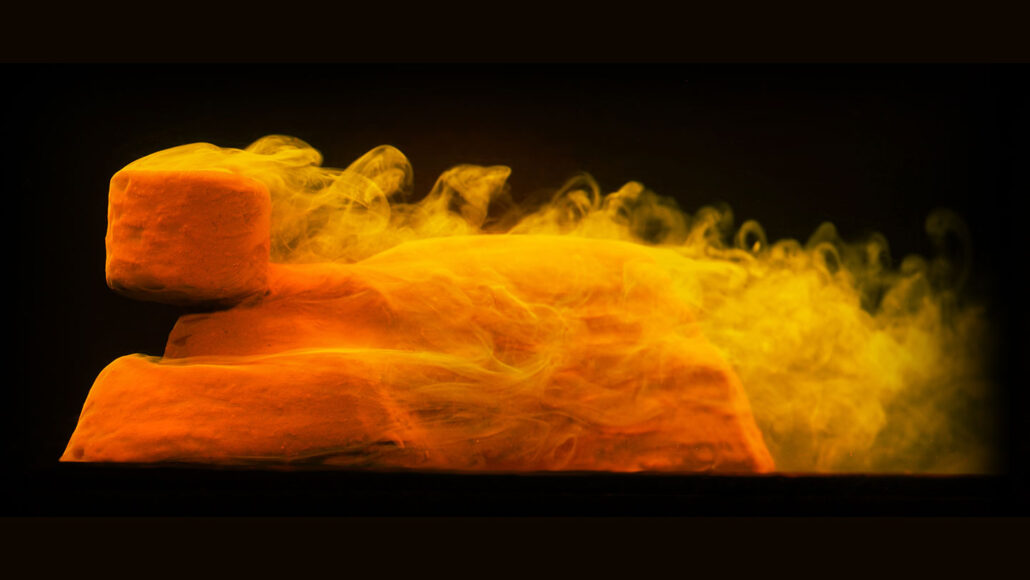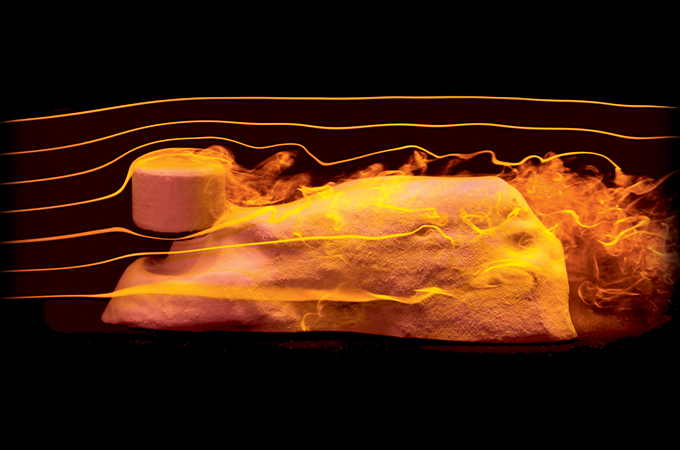Before the ancient Egyptians, nature may have carved sphinxes
Steady ‘winds’ can sculpt sphinxlike ridges called yardangs out of clay blobs

Particles mixed with fluorescent dye light up water currents that swirl around a clay-coated, 3D-printed “sphinx.” This shows how winds might have helped carve similarly shaped objects in some desert environments.
Applied Math Lab/NYU
By Elise Cutts
The Great Sphinx of Giza might have been sculpted by desert winds long before humans carved into it.
Mysterious natural desert structures called yardangs look a lot like seated lions. Some researchers now think the ancient Egyptians might have carved the Great Sphinx out of one.
Built around 4,500 years ago, this massive statue sports the head of a woman and body of a lion. A new study shows that this general shape forms under fairly simple natural conditions — no people needed. Scientists were able to shape their own sphinxlike mini-yardangs from clay globs immersed in flowing water.
“This just came completely out of left field,” says Elena Favaro, who did not take part in the new study. She works at the Open University in Milton Keynes, England. There, Favaro studies how forces such as ice, wind and water can shape Earth’s surface.

Yardangs can evolve naturally in desert regions where winds wear exposed rock into long, streamlined ridges. But scientists aren’t sure what triggers yardangs to form. The new study, Favaro says, is “a very inspired way” to approach answering the question.
Researchers at New York University (NYU) reported their new findings November 16 in Physical Review Fluids.
Leif Ristroph was curious about how nature produces sphinxlike yardangs. This applied mathematician and his team at NYU’s mathematics college study how natural features form and change. Ristroph designs experiments that mimic the erosion of rock by natural forces (such as wind, water and ice). In nature, erosion often occurs over thousands of years or more. To study it in the lab, Ristroph’s team sped up the process. Using a water tunnel, their method takes only a few hours. The tunnel uses water currents to study how air or other fluids flow around stiff objects, such as wings.
“[We can] put things like a piece of ice in there and look how it changes shape,” Ristroph says. Or, “in this case, a chunk of mud.” His team subjected their water tunnel to hundreds of muddy trials.
Each time, they started with a stiff clay paste. The researchers sculpted it into a glob and then embedded it with bits of hard plastic. These bits represented harder parts of natural rock. Then they plopped the globs into the water tunnel. Afterward, they watched a steady water current — meant to mimic wind — erode the clay away.
This setup repeatedly produced sphinxlike mini-yardangs.
Two conditions were key, the researchers found. First, they needed consistent, strong “wind” flow. And the starting blob had to contain a mix of both easily eroded and more-resistant bits. The starting shape of the glob and placement of the hard bits didn’t matter much. The plastic bits just needed to be somewhere in the side facing the “wind.”
Once formed, though, the sphinxes dissolved quickly. So the team had to get creative to snap pictures of the currents in action.
A fluid ‘mane’
Researchers made 3D-printed models and coated them in clay mixed with fluorescent dye. This helped them see how currents flow around sphinxlike shapes carved out of clay by water. One of those replicas is shown here from the side (top) and the top (bottom). The lines around the mini-sphinx are from upstream injections of glowing dye. These help reveal how currents swirl around the object.


The researchers scanned their newly made mini-yardangs using an optical scanner. It uses light to capture digital images of an object from different angles. They used those scans to 3D-print reusable plastic replicas. Then they coated the printed models with a thin layer of clay mixed with fluorescent dye.
In the water tunnel, the glowing clay allowed the researchers to trace how currents flowed around the blob. A turbulent “mane” of eddies (swirling currents of water) formed behind the sphinx’s head. These eddies carved out the yardang’s sloping, catlike spine. The team is now working to model these patterns using math.
From these small-scale studies, it’s not yet clear how wind could erode massive rocks into quirky yardangs. Ristroph hopes his team’s mini-sphinxes will inspire others to investigate such questions.







